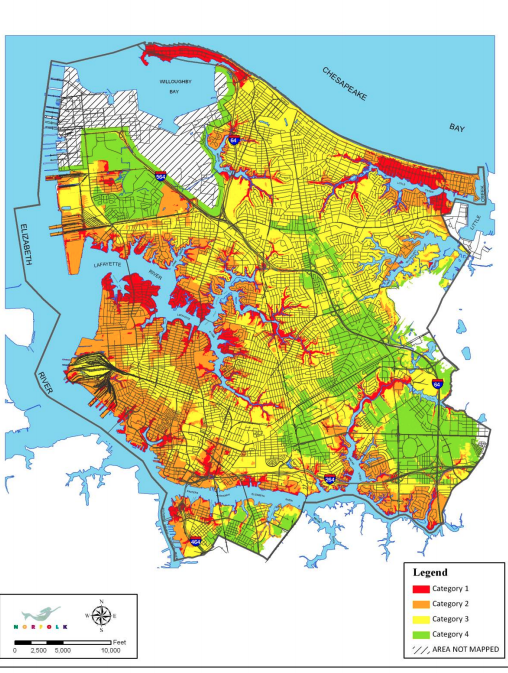
Norfolk’s susceptibility to flooding from storm surge, from the city’s plaNorfolk2030 planning publication.
By Julianna Schroeger
On March 26, Paula Shea, an alum of UNC’s City and Regional Planning program, and Chief Planner for the city of Norfolk, Virginia, presented to our class about the resilience initiatives southeastern Virginia has undertaken. Shea kicked off the presentation, which was part of the Natural Hazards Resilience Speakers Series, by acknowledging the role of resilience in responding to crises such as the COVID-19 pandemic we find ourselves in now. She noted how the use of technology and ability to adapt classes, jobs and even public meetings to virtual formats serves as a prime example of a resilient strategy.
Norfolk, with its 144 miles of coastline, is a city that relies heavily upon its coastal resources. Norfolk is home to the world’s largest naval station and the third-busiest port on the East Coast of the United States. At the same time, Norfolk and the southeastern Virginia region as a whole has a long history of flooding and faces increasing challenges due to rising sea levels and more extreme storms. Shea dated the city’s flooding back to the 1700s, when a hurricane in 1749 shifted the topography of the land, adding several acres of sand bar to the city’s boundaries. The community of Willoughby was subsequently developed on that new dry land but is now among the most vulnerable in the region to flooding. Additionally, sea level is rising in southeastern Virginia faster than the global average, compounded by land subsidence at a rate of about 2 millimeters per year. The region is especially vulnerable because of this, and is frequently inundated by flooding from high tides, heavy rain and storm surge.
The city’s historical connection to the water, reliance upon coastal industry and its vulnerability to coastal changes accelerated by climate change makes it a particularly important place to develop and implement resilience strategies. Shea reviewed the hard infrastructure improvements that city engineers have pursued to address local flooding issues and emphasized the important role that planners play in including residents in community resiliency projects. Norfolk began its resilience planning in 2013 when it joined the 100 Resilient Cities initiative. This initiative, funded by the Rockefeller Foundation, incentivized cities around the world to share information and create local resiliency plans. Out of this initiative, Norfolk, like many cities involved, hired their first Chief Resilience Officer and developed their first resilience strategy. This strategy not only considered coastal resilience, but included economic and social resilience as well.
To continue their quest for resilience, Norfolk then hosted “Dutch Dialogues” in 2015, which brought in Dutch planners and engineers to examine infrastructural and flooding challenges in Norfolk. The recommendations that came out of this event aimed to address flooding issues while also achieving co-benefits for communities. One unique idea that utilized adaptive stormwater management included offering homeowners whose basements already flooded frequently to continue to hold that water during storms in exchange for waiving their stormwater tax. Instead of raising or relocating homes, this strategy is less disruptive and utilizes the natural system already in place.
Equipped with a more holistic view of resilience and innovative nature-based and adaptive water management strategies, the City of Norfolk created Vision 2100 to address long-term sea level rise adaptation. This initiative involved asset and risk mapping through extensive public meetings, and identified four major goals: Designing new dense urban centers in low-risk areas; enhancing economic engines (such as the naval base and port) in high-risk areas; adapting to rising waters in areas that experience frequent inundation; and establishing neighborhoods of the future by investing in connectivity between low-income areas and economic assets. This comprehensive plan for Norfolk’s future prioritizes collaboration between residents and government agencies and includes multi-faceted approaches to tackling resilience. It is clear that collaboration between planners, engineers, and great effort put toward community buy-in has made Norfolk among the most prepared cities in the region.
Julianna Schroeger is a first-year graduate student in Duke University’s Coastal Environmental Management program and is pursuing UNC’s Natural Hazards Resilience Certificate. She is focusing on how equitable economic development opportunities and offshore energy transitions can be incorporated into climate adaptation planning to increase resilience of coastal communities. Julianna has a BS in Marine Biology from UNC Wilmington and previously worked for a resilience-focused NGO in New York City.

